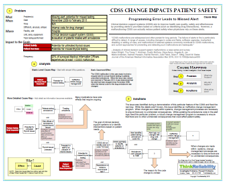By Kim Smiley
Research has been suspended at two National Institutes of Health (NIH) facilities – a National Cancer Institute laboratory working on cell therapy production and a National Institute of Mental Health facility that makes positron emission tomography materials – over concerns about patient safety. A panel of experts determined that these facilities were not in compliance with quality and safety standards and they are shut down pending a review and any necessary upgrades.
 A Cause Map, a visual format for root cause analysis, can be built to help understand this issue. The first step in the Cause Mapping process is to fill in an Outline with the basic background information for an issue, along with how the issues impacts the overall goals. Thankfully, no patient harm has been identified as a result of issues at the facilities, but the potential for patient harm existed and potential impacts should be included on the Outline. No new patients will be enrolled in the affected trials until the issues are resolved and this is an impact to the schedule/operations goal. Once the Outline is complete, the Cause Map is then built by asking “why” questions and the answers are laid out to visually show the cause-and-effect relationships. (Click on “Download PDF” to see a completed Outline and high level Cause Map of this issue.)
A Cause Map, a visual format for root cause analysis, can be built to help understand this issue. The first step in the Cause Mapping process is to fill in an Outline with the basic background information for an issue, along with how the issues impacts the overall goals. Thankfully, no patient harm has been identified as a result of issues at the facilities, but the potential for patient harm existed and potential impacts should be included on the Outline. No new patients will be enrolled in the affected trials until the issues are resolved and this is an impact to the schedule/operations goal. Once the Outline is complete, the Cause Map is then built by asking “why” questions and the answers are laid out to visually show the cause-and-effect relationships. (Click on “Download PDF” to see a completed Outline and high level Cause Map of this issue.)
So why was work at two NIH facilities shut down? A little background is needed to understand this issue. In April 2015, fungal contamination was found in products that were supposed to be sterile that were prepared at a different NIH facility, the Clinical Center’s Pharmaceutical Development Service. The investigation into the contaminated product found multiple deficiencies, both in the facility itself and in work practices. The deficiencies included a filter missing in an air handling system and insects found in two light bays in clean rooms. (Read our previous blog to learn more.) Following this issue, the director of NIH appointed a panel of experts to review safety compliance at all other NIH facilities that produce sterile or infused products for administration to research participants.
The panel’s evaluation is still underway, but preliminary findings determined that the two facilities in question are not in compliance with quality and safety standards and production has been suspended as a result. The panel found that NIH has many outdated or inadequate facilities and that personnel lack expertise on applicable regulations, but no specific details about the deficiencies found have been released. NIH plans to do a rigorous review to identify and correct issues found before these facilities resume manufacturing sterile products. No timeline has been given at this point.
The final step in the Cause Mapping process is to identify and implement solutions to reduce the risk of similar errors reoccurring in the future. In addition to correcting the deficiencies found at these facilities, NIH is working on creating more oversight to help ensure manufacturing facilities are in compliance with safety regulations. The panel recommended the creation of both an outside hospital board to oversee the clinical center and a new central office to coordinate research quality and safety oversight.
Only time will tell how effective these solutions prove to be, but I find it promising that NIH proactively reviewed all of the facilities that produce sterile or infused products for administration to research participants following the fungal contamination issues last year. It may be painful and embarrassing to suspend work at facilities, but the process is at least moving in the right direction if problems can be corrected before patients are harmed.




